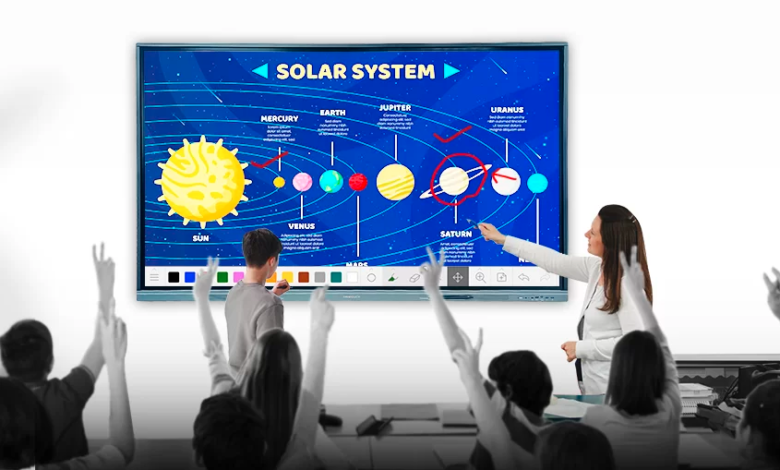The Role of Interactive Panels in Creating a More Inclusive Classroom Environment

Inclusivity in education is more than just a buzzword—it’s a fundamental principle that ensures every student, regardless of their abilities, learning styles, or backgrounds, has the opportunity to succeed. As classrooms become more diverse, the need for inclusive teaching tools has never been greater. Interactive panels for education are emerging as a powerful solution, transforming traditional learning spaces into dynamic, engaging, and inclusive environments where all students can thrive.
The Challenge of Inclusivity in the Classroom
Creating an inclusive classroom means addressing the varied needs of students, including those with different learning abilities, languages, and physical or cognitive challenges. Traditional teaching tools, like chalkboards, printed materials, and basic projectors, often fall short of meeting these diverse needs. Students who struggle with reading, hearing, visual processing, or engagement can feel left behind, leading to lower academic performance and diminished self-confidence.
Teachers face the challenge of delivering lessons that cater to a wide range of learning styles—visual, auditory, kinesthetic—and ensuring that every student can access and engage with the material. This is where interactive panels come into play, offering a versatile, technology-driven solution that supports diverse learners and fosters an inclusive educational experience.
How Interactive Panels Promote Inclusivity in the Classroom
Interactive panels are large, touch-sensitive displays that combine the functionalities of a digital whiteboard, computer, and multimedia center into one tool. These panels are designed not only to enhance learning but also to create a more inclusive environment where every student can participate actively. Here’s how interactive panels for education are making classrooms more inclusive:
- Supporting Diverse Learning Styles: Interactive panels cater to various learning styles, making lessons more accessible to all students. For visual learners, the panels provide vibrant graphics, videos, and interactive simulations that bring concepts to life. Auditory learners benefit from embedded audio features, such as voiceovers and sound effects, that reinforce lesson content. Kinesthetic learners can interact with the screen, drawing, writing, or manipulating objects, which helps them engage more deeply with the material. By integrating multiple modes of learning, interactive panel ensure that no student is left out of the learning process.
- Enhancing Accessibility for Students with Disabilities: For students with physical or cognitive disabilities, interactive panels offer features that can make learning more accessible. For instance, students with visual impairments can benefit from adjustable text sizes, high-contrast modes, and audio descriptions. Those with hearing impairments can use captioned videos or participate in lessons where instructions are also visually displayed. Interactive panels can also be operated using touch or stylus input, which helps students with fine motor skill difficulties interact with the content in a way that works best for them. These adaptive features ensure that students with disabilities can fully engage in classroom activities alongside their peers.
- Facilitating Multilingual and Language Learning: In classrooms with students from diverse linguistic backgrounds, language barriers can hinder learning and participation. Interactive panels can support multilingual learning environments by incorporating translation tools, language-specific resources, and visual aids that help bridge communication gaps. For example, a teacher can use the panel to display vocabulary words in multiple languages or use text-to-speech functions to assist with pronunciation and language comprehension. This approach not only supports English language learners but also enriches the learning experience for all students by promoting cultural inclusivity and language diversity.
- Encouraging Class Participation: Interactive panels create a safe space for all students to participate without the fear of judgment. Shy or anxious students who may hesitate to raise their hand in a traditional setting can interact with the panel from their desks using connected devices or by writing their answers directly on the screen. This method encourages more students to engage in discussions and activities, as they can contribute without the pressure of speaking out loud. By reducing barriers to participation, interactive panels help build confidence and foster a more inclusive classroom culture.
- Customizing Learning Experiences: Every student learns at their own pace, and interactive panels allow teachers to customize lessons to meet individual needs. For example, during a math lesson, advanced students can work on challenging problems on one side of the panel, while students needing extra support can work on foundational skills on the other side. This differentiation ensures that all students are engaged at their level of understanding. Teachers can also save personalized notes and annotations for each student, providing tailored feedback that helps guide their progress. This personalized approach makes learning more relevant and accessible for every student.
- Creating a Collaborative Learning Environment: Interactive panels are designed to promote collaboration among students, making the classroom a shared space for learning. Group activities, such as brainstorming sessions, problem-solving challenges, and interactive games, can be conducted directly on the panel, encouraging students to work together and share ideas. For instance, in a social studies class, students can collectively build a timeline of historical events, add multimedia content, and discuss their findings—all on the interactive panel. This collaborative aspect not only enhances learning but also helps students develop essential social skills like teamwork, communication, and empathy.
Real-World Examples: Inclusivity in Action
Schools that have integrated interactive panels for education into their classrooms are seeing remarkable improvements in inclusivity and student engagement. In one elementary school, teachers used interactive panels to support students with learning disabilities by incorporating interactive phonics programs that help with reading comprehension. The panels allowed students to hear, see, and interact with letters and words, making learning more engaging and effective.
Read also: Why You Need to Incorporate Techy Hit Tools in Your Business Strategy Today
In another example, a high school used interactive panels to accommodate students with varying language skills. By integrating language translation features and visual aids, teachers were able to communicate more effectively with non-native speakers, allowing them to participate fully in classroom discussions and group activities. This approach not only improved language skills but also fostered a more inclusive and supportive learning environment.
Conclusion: A Step Towards a More Inclusive Future
Interactive panels are more than just technological advancements—they are essential tools in creating inclusive classrooms where every student can thrive. By addressing diverse learning needs, enhancing accessibility, and encouraging participation, interactive panels help ensure that all students, regardless of their abilities or backgrounds, have equal opportunities to learn and succeed.
For educators committed to inclusivity, interactive panels are not just a luxury but a necessity. They provide a flexible, engaging, and supportive environment that empowers students and enriches the learning experience. As we continue to move towards more inclusive educational practices, interactive panels for education will play a crucial role in shaping the classrooms of the future—classrooms where every student is seen, heard, and valued.





